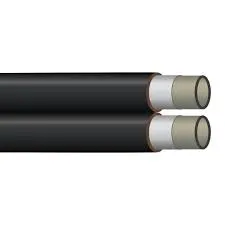jul . 02, 2024 15:03 Back to list
Exploring Thermoplastic Hoses: Materials, Construction, and Applications
Exploring Thermoplastic Hoses: Materials, Construction, and Applications

Introduction
Thermoplastic hoses represent a versatile and durable option in the world of industrial hoses, catering to a wide range of applications across various industries. Known for their strength, flexibility, and resistance to a variety of chemicals and environmental factors, these hoses also offer specific benefits such as electrical non-conductivity. In this blog, we'll delve into the materials used in the construction of thermoplastic hoses, how they are made, their diverse applications, and the significance of non-conductive properties.
Materials and Construction of Thermoplastic Hoses
1. Thermoplastic Materials: The primary materials used in the construction of thermoplastic hoses include:
- Polyurethane (PU): Known for its exceptional flexibility, abrasion resistance, and strength, polyurethane is ideal for hoses that require a tight bend radius and robust physical properties.
- Nylon (Polyamide): Nylon is valued for its excellent chemical resistance and temperature handling capabilities, making it suitable for high-pressure applications.
- Polyvinyl chloride (PVC): PVC hoses are lightweight, affordable, and resistant to a variety of chemicals, though they are generally used in lower-pressure applications.
- Polytetrafluoroethylene (PTFE): Often used in high-purity applications, PTFE offers outstanding chemical resistance and can handle a wide temperature range.
- Thermoplastic rubber (TPR): Combining the properties of rubber and plastic, TPR is flexible and durable, often used in environments requiring resistance to weather and varying temperatures.
#2. Hose Construction: Thermoplastic hoses typically consist of three layers:
- Inner Tube: The inner tube, made from one of the thermoplastics mentioned above, is designed to be compatible with the fluid it carries, ensuring chemical stability and resistance.
- Reinforcement Layer: This layer often consists of woven or braided fibers or steel wire, providing the strength needed to handle internal pressures and help maintain the hose's shape.
- Outer Cover: The outer layer of a thermoplastic hose protects against environmental damage, abrasion, and UV radiation, and is also made from a tough thermoplastic material.
THERMOPLASTIC HOSE SAE 100 R7/ EN 855R7
Non-Conductive Thermoplastic Hoses
Some thermoplastic hoses are specifically designed to be non-conductive. These non-conductive hoses are essential in environments where there is a risk of electrical shock or where hoses might come into contact with exposed electrical components.
Purpose of Non-Conductivity:
- Safety: Non-conductive hoses enhance safety by preventing the transfer of electrical current, which is crucial in areas where operators or machinery are exposed to electrical systems.
- Prevention of Electrical Interference: In environments where electronic equipment is sensitive, non-conductive hoses prevent any possibility of electrical interference from static electricity build-up.
Applications such as hydraulic powered platforms, near high-voltage equipment, or in applications involving flammable liquids benefit greatly from non-conductive hoses to ensure operational safety and integrity.
Applications of Thermoplastic Hoses
Thermoplastic hoses find their applications in various sectors due to their diverse properties. Some of the key applications include:
- Hydraulic Systems
- Pneumatic Tools
- Automotive Industry
- Food and Beverage
- Chemical Processing
- Water Treatment
- Paint Spray Systems
- Car Wash Assemblies
The versatility and robust nature of thermoplastic hoses, combined with their non-conductive properties when required, make them an ideal choice in industries where durability, flexibility, and safety are paramount.
Conclusion
Thermoplastic hoses are a crucial component in a myriad of industrial applications, prized for their versatility, durability, and performance under a variety of conditions. Whether resisting harsh chemicals, enduring high pressures, providing flexibility, or ensuring safety through non-conductivity, thermoplastic hoses meet the diverse needs of modern industries efficiently. By selecting the appropriate material and construction, users can greatly enhance the functionality and longevity of their systems.
-
Smooth Cover Hydraulic Rubber Hose High-Pressure & Durable OEM Solutions
NewsMay.17,2025
-
Steel Spiral Wire Hydraulic Hose Supplier China Durable OEM Solutions
NewsMay.17,2025
-
Flex Hydraulic Hose High-Pressure Durable Steel & Teflon Solutions
NewsMay.17,2025
-
Extremely High Pressure Hydraulic Hose Durable & High-Performance Solutions
NewsMay.16,2025
-
Marine Hydraulic Hose Flexible R5 Soft Rubber Hoses for High Pressure
NewsMay.16,2025
-
Parker Metal Hose High-Performance Flexible Hydraulic Solutions
NewsMay.16,2025

